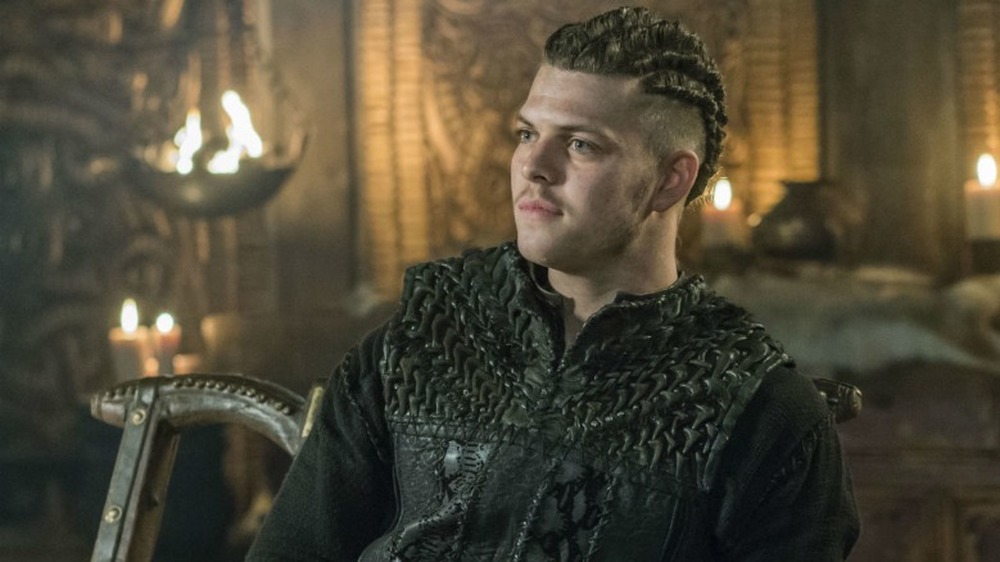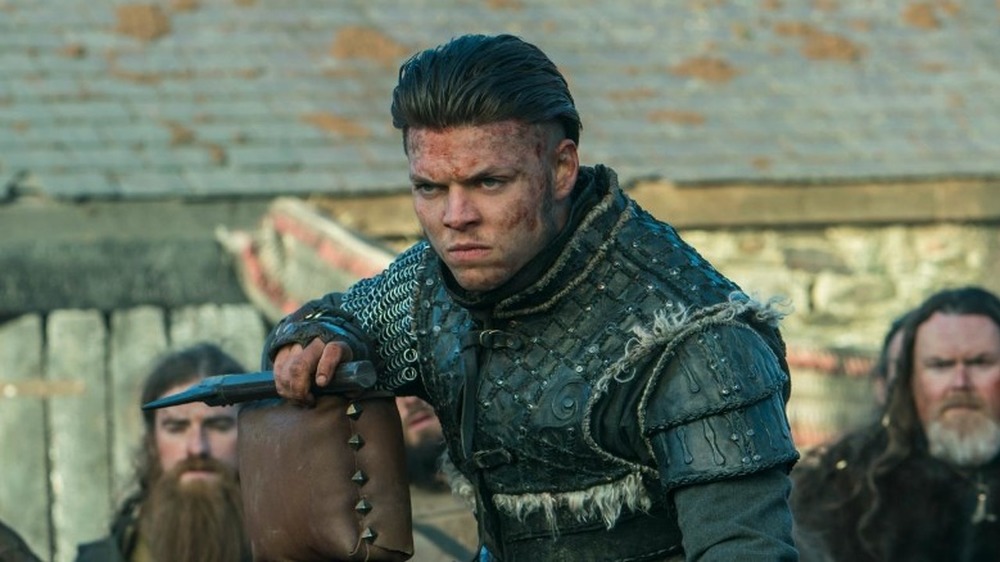The Real Meaning Behind Ivar The Boneless' Name On Vikings
Among the many reasons Vikings captivated audiences and left a big mark during its six-season run, an especially notorious one was its attention to detail when it came to Norse culture. In order to truly immerse viewers in the world of medieval Scandinavia and go beyond the traditional Anglo-Saxonic depiction of Vikings as bloodthirsty villains, series creator Michael Hirst and the whole creative crew did tireless research to get every little thing as right as possible, from the costumes to the customs to, well, the execution methods.
For those unfamiliar with the history depicted, one of the show's most fascinating and memorable aspects was right there in the cast list. Regardless of your opinions on Ragnar Lothbrok, Queen Aslaug, or Lagertha as characters, it was impossible to forget their unique Nordic names. Most of the major characters in Vikings are based on real historical figures or legends, and their names carry all the weight of that history. Ragnar's nickname "Lothbrok," for example, means "shaggy-breeches" in Old Norse, and refers to the unusual clothes the legendary Ragnar is said to have worn to battle with a dragon.
Over the course of the show, five historical vikings believed to have been Ragnar's sons become central characters. One of them, Ivar the Boneless (Alex Høgh Andersen), is maybe the show's most controversial figure among fans, and a look into the origins and meaning of his name reveals that may have also been the case for the real-life Ivar.
Ivar is a popular Norwegian name to this day
While names such as Lagertha and Floki are less commonly used in Scandinavia nowadays, Ivar's name has managed to retain its 9th-century popularity. According to official statistics, it's currently the 50th most popular male name in Norway.
Although part of that popularity can be attributed to its historical importance, given that Ivan the Boneless was a major leader in the Viking conflict with England, it's also possible that Norwegian parents take to the name because of its strong meaning. "Ivar" is believed to be a composite of two Old Norse words: ýr, meaning "bow" or "archer," and hariar, meaning "warrior." Ivar, therefore, would mean something like "Archer warrior" — a name that certainly befits the Vikings character's belligerent temper, even if we never see him do any archery.
Of course, it depends on who you ask. The word ýr can also mean "yew tree," as in the European conifer famous for its highly poisonous nature. Interestingly, this dovetails with the tense friendship between Ivar and the Slavic prince Oleg of Novgorod, who narrowly escapes death by poisoning and later poisons his own brother in a power play.
Then again, unlike most character names with a special meaning, Ivar's name wasn't chosen by the writers. So even with all that potential thematic resonance, it doesn't really qualify as an "Easter egg" like, say, the names in WandaVision.
Boneless may not mean what you think it means
The part of Ivar's name that's really fascinating to dig into is the epithet "Boneless." Aside from having Ragnar himself bestow the name upon his own son, the show hews close to the most common legendary origin for it: after Ragnar disrespects a prophecy, his child is born with a bone malformation that renders his legs weak. This legend has led some researchers to theorize that Ivar suffered from brittle bone disease.
But not all historians agree with this reading of the written records. According to Robert Ferguson's book The Hammer and the Cross: A New History of the Vikings, some scholars believe that the description of him as beinlausi ("without bones" or "without legs/feet") was metaphorical — a reference to his cunning, "snakelike" efficiency as a war strategist. Others argue that "Boneless" is a mistranslation of the Latin word exosus, which means "detested."
And while that kind of reputation would seem to track with the Ivar we know from Vikings, there's also a third, more surprising theory: Since the Old Norse Tale of Ragnar's Sons describes him as lustless and childless, the word "Boneless" could even refer to sexual impotence.
Despite the lack of a consensus, the most common theory supported by the majority of Norse stories, is still that the "Boneless" title refers to some kind of disability, as seen in the show. Even so, in the 1970s and '80s, a series of archaeological expeditions on the site of the Battle of Repton (depicted in the Vikings season 4 finale) unearthed a skeleton believed to belong to the real Ivar... and it painted a picture of him as a tall man with healthy bones.
Long story short, historical truth is hard to pin down. That makes it all the more impressive that Vikings made it look and feel so alive.


